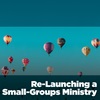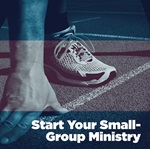The host model is a popular strategy for small-group ministry today. Most commonly associated with Saddleback Church in Southern California, this model has proven effective for several churches. But no model is right for every church. Is it right for yours?
The Basics
The host model is named after the idea of recruiting people to "host" a small group. Saddleback found when they tried to recruit "leaders," people were reluctant to volunteer, but when they changed their strategy to recruiting hosts, people were much more willing to jump on board. Saddleback uses an acronym to describe the host's responsibilities: Have a heart for people, Open your place, Serve a snack, and Turn on the DVD.
At Saddleback, hosts are often recruited during one of the church's campaigns (they do two or three of these a year). The purpose of a campaign is for the entire church body to be studying the same curriculum at the same time. Rather than finding and leading a study on their own, hosts are given the curriculum from the church—often a DVD-based study. The group will hear from a master teacher on the DVD, and the host will facilitate the discussion time by asking the prepared questions. When the church is not doing a campaign, they ask groups to select a study of their choosing based on the interest of the members and their spiritual maturity.
With the host model, churches usually provide a way for people to find and sign up for a group—either on their church website or at a small group table available before and after church services. With larger churches, often people can request a group specifically for their gender, age, marital status, etc. Saddleback encourages group members to invite church members, non-church members, and neighbors to their group. Everyone is welcome.
Choosing and Training Leaders
Pretty much anyone in the church who is willing to host can. Initially, the bar for hosting is set very low. At Saddleback, they expect hosts to commit to about six weeks, depending on the length of the campaign study. Once the study is over, hosts can decide whether or not they want to continue leading the group. For Saddleback, the goal is to transform a host into a small-group leader who accepts the role of spiritual leader for the group. To become a spiritual leader, the bar is raised. Interested hosts go through leadership training and development. There are also additional leadership guidelines they must agree and adhere to.
Key Values
In order to determine whether or not the host model would work well in your church, it helps to know some of its key values:
- Having as many groups as possible
- Allowing the groups to be as large or small as desired
- Recruiting hosts with the goal of later training them to become leaders
- Using a campaign a few times a year to recruit hosts and form more groups
Strengths
In light of Saddleback's success with their small-group ministry, it's easy to see how this kind of model can be effective. Here are some of its strengths:
- Because the requirements for being a host are low, many new small groups can be formed quickly.
- With lots of groups formed quickly, it's easy to connect lots of people in your church into small groups.
- This model provides a way for potential leaders to ease into the responsibilities of leading a small group.
- If the pre-packaged curriculum is of high quality, the teaching time can be as good as or better than a traditional small-group Bible study.
- The pre-packaged curriculum is usually based on a church-wide campaign, which allows the entire church to be on the same page.
- The size of the group is open. This gives the host and the group members freedom to keep the group small or invite others.
Weaknesses
Of course with any model, there are weaknesses. Here are some of the host model's potential pitfalls:
- Because the requirements are low for being a host, churches may recruit leaders who are not ready for the responsibility of full spiritual leadership.
- With so many new groups and hosts, it's difficult to control (or perhaps even know) what's happening during the group meetings.
- Host groups are dependent on the quality of the pre-packaged curriculum. Even if the curriculum is of high quality, it may not meet the needs or spiritual maturity of the group members. In addition, many pre-packaged curricula are not of high quality and may fall flat.
- Because hosts are not required to continue leading the group after a campaign has ended, a church can lose as many (or nearly as many) groups as they gained during the course of a campaign.
- With no limit on how large or small groups are, hosts could run into many issues with group dynamics. For instance, some people might not be willing to be transparent with one another if the group has too many people.
- If a host decides they don't want to go through the leadership training and continue leading the group, group members can be left hanging, having to look for and join a different group—even one that has already been established.
—Jamie Mitchell served as an intern for SmallGroups.com; copyright 2013 by Christianity Today.











